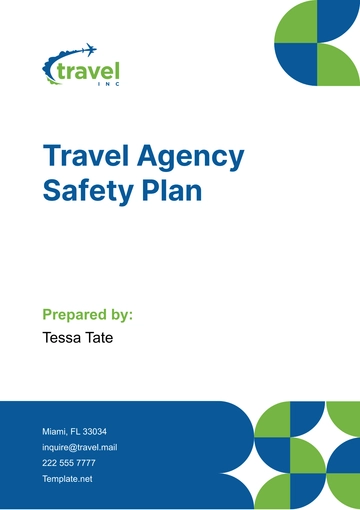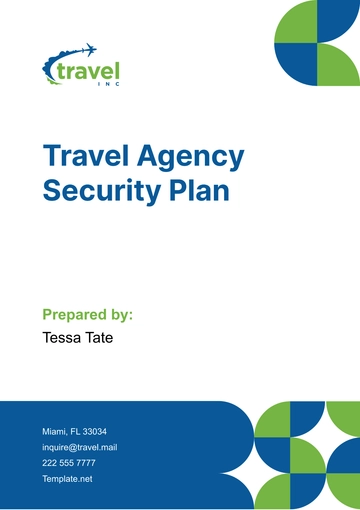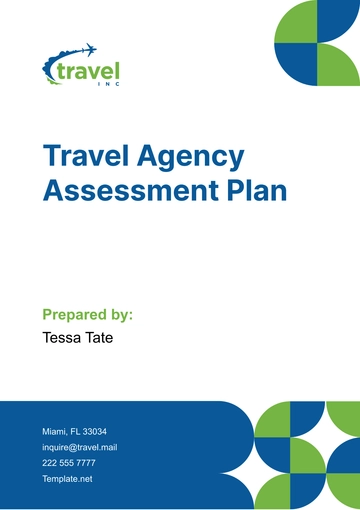Free Travel Agency Security Plan

A. Executive Summary
The purpose of this Travel Agency Security Plan is to establish a comprehensive security strategy aimed at safeguarding both the physical and digital assets of [Your Company Name], thereby ensuring the safety and confidentiality of both staff and customer data. In an ever-evolving landscape of security threats, this document outlines proactive measures and responsive strategies necessary to mitigate risks effectively and respond swiftly to security incidents. By implementing robust security protocols, our goal is to uphold the agency’s reputation as a safe and reliable provider of travel services, fostering trust among our valued clients and partners.
This plan emphasizes the importance of proactive security measures, including but not limited to, physical security enhancements, cybersecurity protocols, and staff training initiatives. Additionally, it delineates clear procedures for incident response and crisis management, ensuring that the agency is well-prepared to handle security breaches or emergencies. By prioritizing the protection of assets and data, [Your Company Name] aims to not only meet regulatory requirements but also exceed customer expectations, thereby reinforcing our commitment to providing unparalleled service in a secure environment.
B. Assessment of Current Security Posture
The first crucial step in crafting an effective Travel Agency Security Plan is conducting a comprehensive assessment of the current security posture within [Your Company Name]. This assessment encompasses a thorough evaluation of existing security measures and potential vulnerabilities across various domains, including physical security systems, IT infrastructure, employee awareness, and adherence to policies and procedures. By scrutinizing these aspects, we aim to identify areas of strength as well as opportunities for improvement, thereby informing the development of tailored security strategies.
The assessment of physical security systems involves reviewing access control mechanisms, surveillance systems, and perimeter security measures implemented at [Your Company Name]'s premises. Likewise, the evaluation of IT infrastructure entails examining network architecture, data storage protocols, and cybersecurity measures to ascertain their effectiveness in safeguarding against digital threats. Additionally, assessing employee awareness involves gauging the level of understanding and adherence to security policies and procedures through training records and awareness campaigns.
Based on the findings of this assessment, [Your Company Name] will be able to customize security strategies and prioritize initiatives that address identified vulnerabilities and strengthen existing security measures. This proactive approach ensures that our security plan is not only comprehensive but also tailored to the specific needs and risk profile of our travel agency. By continuously reassessing and refining our security posture, we uphold our commitment to providing a safe and secure environment for both our staff and valued customers.
C. Objectives of the Security Plan
The primary objectives of this Travel Agency Security Plan are:
Prevent unauthorized access to the agency’s premises and technological systems.
Protect sensitive customer information from breaches.
Ensure continuity of operations under various threat scenarios.
These objectives are meticulously designed to align with regulatory requirements and best practices in the travel industry. By focusing on preventing unauthorized access, safeguarding customer data, and maintaining operational resilience, [Your Company Name] aims to uphold the highest standards of security and trustworthiness. Through proactive measures and responsive strategies outlined in this plan, we are committed to mitigating risks effectively and ensuring the safety and confidentiality of both our staff and customers.
D. Risk Assessment and Management
Risk assessment is critical in identifying key areas of potential threats to both physical and digital assets. The following table outlines the identified risks, their likelihood, potential impact, and proposed mitigation strategies:
Risk | Likelihood | Impact | Mitigation Strategy |
|---|---|---|---|
Data Breach | High | Severe | Implement enhanced encryption, secure data storage and regular audits |
Physical Security Breach | Medium | Moderate | Upgrade access control systems and surveillance technology |
Phishing Attacks | High | High | Conduct regular staff training on identifying phishing attempts |
Natural Disasters | Low | High | Develop and implement a comprehensive disaster recovery plan |
Internal Malfeasance | Medium | High | Enforce strict access controls and regular internal audits |
E. Security Policies and Compliance
Ensuring adherence to industry standards and regulatory requirements is paramount in maintaining the security of [Your Company Name]. This section outlines policies governing key aspects of security management, including data protection, physical security, and employee conduct. The agency commits to compliance through regular policy reviews and updates, thereby reinforcing its dedication to upholding the highest standards of security and trustworthiness.
Security Policies and Compliance Framework
Data Protection Policy
Physical Security Policy
Employee Conduct Policy
F. Physical Security Measures
Physical security measures play a critical role in safeguarding the physical assets and personnel of [Your Company Name]. This section outlines the various measures implemented to ensure the security and safety of our premises, staff, and clients.
1. Secured Entry Points
[Your Company Name] employs controlled access mechanisms, such as keycard systems or biometric scanners, to regulate entry into our facilities. Access is restricted to authorized personnel only, reducing the risk of unauthorized intrusion.
2. Surveillance Systems
We maintain comprehensive surveillance systems, including CCTV cameras strategically positioned throughout our premises to monitor activities and deter potential threats. These systems provide real-time monitoring and recording capabilities to enhance security and facilitate incident investigation.
3. Secure Handling and Storage of Physical Documents
All physical documents containing sensitive information are securely stored in designated areas with restricted access. Measures such as locked cabinets, safes, or digital document management systems are employed to prevent unauthorized access and ensure confidentiality.
4. Emergency Response
[Your Company Name] has established clear protocols and procedures for responding to emergencies, including fires, medical emergencies, or security incidents. Emergency exits, evacuation routes, and assembly points are clearly marked and regularly reviewed to ensure effectiveness in emergency situations.
Periodic Reviews and Upgrades
To adapt to evolving security challenges and technological advancements, [Your Company Name] conducts periodic reviews and upgrades of physical security measures. This includes assessing the effectiveness of existing systems, identifying areas for improvement, and implementing upgrades or enhancements as necessary.
G. IT Security Strategies
Protecting [Your Company Name]'s IT infrastructure from digital threats is paramount in today's interconnected world. This section outlines the comprehensive strategies employed to safeguard our digital assets and ensure the integrity, availability, and confidentiality of our information.
1. Robust Firewall Protection
[Your Company Name] utilizes state-of-the-art firewall solutions to monitor and control incoming and outgoing network traffic. This helps prevent unauthorized access and protects against malicious activities such as hacking attempts and malware infections.
2. Advanced Anti-Virus Solutions
We deploy advanced anti-virus software across all devices to detect and remove malware, ransomware, and other malicious software threats. Regular updates and scans are conducted to ensure optimal protection against emerging threats.
3. Intrusion Detection Systems (IDS)
Intrusion detection systems are employed to monitor network traffic for suspicious activity or signs of potential security breaches. By promptly detecting and alerting to anomalous behavior, IDS helps mitigate the risk of cyberattacks and data breaches.
4. Secure Wi-Fi Networks
[Your Company Name] implements secure Wi-Fi networks with encryption protocols such as WPA2 or WPA3 to protect against unauthorized access and eavesdropping. Access controls and strong authentication mechanisms are enforced to ensure that only authorized users can connect to the network.
5. Regular Updates, Backups, and Cyber Incident Response Plans
Regular software updates and patches are applied to all systems and applications to address known vulnerabilities and strengthen security. Additionally, comprehensive data backups are performed regularly to mitigate the impact of data loss or corruption. Cyber incident response plans are in place to facilitate a swift and effective response to security incidents, minimizing disruption to operations and mitigating potential damage.
H. Employee Training and Awareness
Employees are often the first line of defense against security threats. This plan prioritizes regular training on security best practices, emergency procedures, and recognizing potential threats. A bullet list of training topics includes:
Recognizing phishing and social engineering attacks
Proper handling of sensitive information
Emergency evacuation procedures
Usage of security technologies
Compliance with travel industry standards and regulations
I. Incident Response and Recovery
In the unfortunate event of a security breach or another incident, [Your Company Name] is committed to executing a structured and efficient response to minimize impact and restore normal operations promptly. This section details the comprehensive incident response and recovery plan, encompassing procedures, roles and responsibilities, and steps for recovery.
Incident Response Procedures
[Your Company Name] maintains a well-defined incident response plan that outlines the sequence of actions to be taken in the event of a security breach or incident. This includes initial detection and assessment, containment of the incident, eradication of the threat, and recovery of affected systems and data.
1. Roles and Responsibilities
Clear roles and responsibilities are assigned to individuals or teams within [Your Company Name] to ensure an effective incident response. Designated roles may include incident coordinator, technical response team, communication liaison, and management oversight, each with specific duties and authorities.
2. Steps for Recovery
Following containment of the incident, [Your Company Name] initiates the recovery process to restore normal operations. This involves restoring affected systems and data from backups, implementing security patches or updates, and conducting thorough testing to ensure the integrity and functionality of restored systems.
3. Case Management
[Your Company Name] employs a structured case management approach to document and track security incidents from detection to resolution. Each incident is assigned a unique case number, and detailed records are maintained, including incident timelines, actions taken, and outcomes of investigations.
4. Communication Guidelines
Effective communication is essential during an incident to keep stakeholders informed and manage expectations. [Your Company Name] establishes clear communication channels and protocols for internal teams, clients, partners, regulatory authorities, and other relevant parties to receive timely updates and instructions.
5. Evaluation Post-Incident
After the incident is resolved, [Your Company Name] conducts a thorough post-incident evaluation to assess the effectiveness of the response and identify areas for improvement. Lessons learned are documented, and recommendations are implemented to enhance incident response capabilities for future incidents.
J. Monitoring and Evaluation
The effectiveness of the security measures implemented by [Your Company Name] will be regularly monitored and evaluated to ensure alignment with the agency’s operational requirements and emerging threats. This section outlines the processes for ongoing monitoring, assessment, and adjustment of security measures to maintain robust protection.
1. Regular Monitoring
[Your Company Name] conducts continuous monitoring of security systems, processes, and controls to detect and respond to security incidents promptly. This includes real-time monitoring of network traffic, system logs, and security alerts to identify potential threats and vulnerabilities.
2. Performance Metrics
Key performance metrics are established to measure the effectiveness of security measures in mitigating risks and protecting assets. Metrics may include incident response times, incident resolution rates, compliance with security policies, and system uptime.
3. Feedback Mechanisms
[Your Company Name] implements feedback mechanisms to solicit input from stakeholders, including employees, clients, and partners, regarding security concerns, incidents, and suggestions for improvement. This feedback is valuable in identifying areas for enhancement and strengthening security posture.
4. Periodic Evaluation
Regular evaluations are conducted to assess the overall effectiveness of security measures against evolving threats and operational requirements. These evaluations involve reviewing security policies, procedures, and controls, as well as conducting security assessments and audits.
5. Continuous Improvement
[Your Company Name] is committed to continual improvement of its security posture based on monitoring data, performance metrics, feedback, and evaluation results. Adjustments and enhancements to security measures are made proactively to address emerging threats and improve resilience.
- 100% Customizable, free editor
- Access 1 Million+ Templates, photo’s & graphics
- Download or share as a template
- Click and replace photos, graphics, text, backgrounds
- Resize, crop, AI write & more
- Access advanced editor
Ensure safety and security with Template.net's Travel Agency Security Plan Template. This customizable and editable document simplifies the creation of security plans for your agency's operations. Tailored for the travel industry, it ensures comprehensive measures to protect assets and clients. Editable in our Ai Editor Tool, it facilitates seamless customization to meet your specific security requirements.
You may also like
- Finance Plan
- Construction Plan
- Sales Plan
- Development Plan
- Career Plan
- Budget Plan
- HR Plan
- Education Plan
- Transition Plan
- Work Plan
- Training Plan
- Communication Plan
- Operation Plan
- Health And Safety Plan
- Strategy Plan
- Professional Development Plan
- Advertising Plan
- Risk Management Plan
- Restaurant Plan
- School Plan
- Nursing Home Patient Care Plan
- Nursing Care Plan
- Plan Event
- Startup Plan
- Social Media Plan
- Staffing Plan
- Annual Plan
- Content Plan
- Payment Plan
- Implementation Plan
- Hotel Plan
- Workout Plan
- Accounting Plan
- Campaign Plan
- Essay Plan
- 30 60 90 Day Plan
- Research Plan
- Recruitment Plan
- 90 Day Plan
- Quarterly Plan
- Emergency Plan
- 5 Year Plan
- Gym Plan
- Personal Plan
- IT and Software Plan
- Treatment Plan
- Real Estate Plan
- Law Firm Plan
- Healthcare Plan
- Improvement Plan
- Media Plan
- 5 Year Business Plan
- Learning Plan
- Marketing Campaign Plan
- Travel Agency Plan
- Cleaning Services Plan
- Interior Design Plan
- Performance Plan
- PR Plan
- Birth Plan
- Life Plan
- SEO Plan
- Disaster Recovery Plan
- Continuity Plan
- Launch Plan
- Legal Plan
- Behavior Plan
- Performance Improvement Plan
- Salon Plan
- Security Plan
- Security Management Plan
- Employee Development Plan
- Quality Plan
- Service Improvement Plan
- Growth Plan
- Incident Response Plan
- Basketball Plan
- Emergency Action Plan
- Product Launch Plan
- Spa Plan
- Employee Training Plan
- Data Analysis Plan
- Employee Action Plan
- Territory Plan
- Audit Plan
- Classroom Plan
- Activity Plan
- Parenting Plan
- Care Plan
- Project Execution Plan
- Exercise Plan
- Internship Plan
- Software Development Plan
- Continuous Improvement Plan
- Leave Plan
- 90 Day Sales Plan
- Advertising Agency Plan
- Employee Transition Plan
- Smart Action Plan
- Workplace Safety Plan
- Behavior Change Plan
- Contingency Plan
- Continuity of Operations Plan
- Health Plan
- Quality Control Plan
- Self Plan
- Sports Development Plan
- Change Management Plan
- Ecommerce Plan
- Personal Financial Plan
- Process Improvement Plan
- 30-60-90 Day Sales Plan
- Crisis Management Plan
- Engagement Plan
- Execution Plan
- Pandemic Plan
- Quality Assurance Plan
- Service Continuity Plan
- Agile Project Plan
- Fundraising Plan
- Job Transition Plan
- Asset Maintenance Plan
- Maintenance Plan
- Software Test Plan
- Staff Training and Development Plan
- 3 Year Plan
- Brand Activation Plan
- Release Plan
- Resource Plan
- Risk Mitigation Plan
- Teacher Plan
- 30 60 90 Day Plan for New Manager
- Food Safety Plan
- Food Truck Plan
- Hiring Plan
- Quality Management Plan
- Wellness Plan
- Behavior Intervention Plan
- Bonus Plan
- Investment Plan
- Maternity Leave Plan
- Pandemic Response Plan
- Succession Planning
- Coaching Plan
- Configuration Management Plan
- Remote Work Plan
- Self Care Plan
- Teaching Plan
- 100-Day Plan
- HACCP Plan
- Student Plan
- Sustainability Plan
- 30 60 90 Day Plan for Interview
- Access Plan
- Site Specific Safety Plan


















